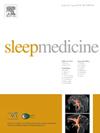Prevalence and association analysis of obstructive sleep apnea in India: Results from BLESS cohort
IF 3.8
2区 医学
Q1 CLINICAL NEUROLOGY
引用次数: 0
Abstract
Background
Despite having the largest population in the world with 1.4 billion inhabitants, there is only scarce data on the prevalence of OSA from India.
Research question
This study aimed to find the prevalence of Obstructive Sleep Apnea (OSA) using Polysomnography (PSG) and current scoring rules (AASM 2012) in population and investigate OSA associations for cardiovascular and metabolic comorbidities.
Study design
and Methods: Participants were randomly selected among the accompanying attendants of patients admitted to a hospital in Bhopal, India and underwent level I PSG. Anthropometric measurements, blood investigations were taken. The primary outcome was prevalence of OSA, assessed by the Apnoea-Hypopnoea Index (AHI).
Results
Level I PSG was performed on 1015 adult participants from December 2019 to February 2023; after excluding 57 participants with sleep time <240 min, 958 participants (age range 18–80 years) were finally included in this study. Median (IQR) age was 40.0 years (31.0, 49.0) while median (IQR) BMI was 23.5 (20.7, 26.8) Kg/m2. Prevalence (95 % CI) of moderate-to-severe OSA (AHI ≥15) and severe OSA (AHI≥30) was 30.5 % (28–34 %) and 10.1 % (8.3–12), respectively. The upper quartile of the AHI (Q4 ≥17) was independently associated with the presence of Diabetes Mellitus [OR 2.14 (95 % CI 1.07–4.44)], Hypertension [OR1.98 (95 % CI 1.20–3.28)] and Metabolic Syndrome [OR 2.36 (95 % CI 1.37–4.09)] compared to the first quartile AHI.
Interpretation
OSA prevalence was found to be significantly higher than previously estimated in Indian population. Association of OSA with diabetes, hypertension, and metabolic syndrome was observed.
印度阻塞性睡眠呼吸暂停的患病率和关联分析:BLESS 队列的结果
研究问题本研究旨在利用多导睡眠图(PSG)和现行评分规则(AASM,2012 年)了解人群中阻塞性睡眠呼吸暂停(OSA)的患病率,并调查 OSA 与心血管和代谢合并症的关联:参与者从印度博帕尔一家医院住院患者的陪护人员中随机抽取,并接受一级 PSG。进行人体测量和血液检查。结果从 2019 年 12 月至 2023 年 2 月,对 1015 名成年参与者进行了 I 级 PSG;在排除了 57 名睡眠时间为 <240 分钟的参与者后,最终有 958 名参与者(年龄范围为 18-80 岁)被纳入本研究。年龄中位数(IQR)为 40.0 岁 (31.0, 49.0),体重指数中位数(IQR)为 23.5 (20.7, 26.8) Kg/m2。中重度 OSA(AHI ≥15)和重度 OSA(AHI ≥30)的患病率(95 % CI)分别为 30.5 %(28-34 %)和 10.1 %(8.3-12)。与第一四分位 AHI 相比,AHI 的上四分位(Q4 ≥17)与糖尿病[OR 2.14 (95 % CI 1.07-4.44)]、高血压[OR 1.98 (95 % CI 1.20-3.28)]和代谢综合征[OR 2.36 (95 % CI 1.37-4.09)]的存在独立相关。OSA与糖尿病、高血压和代谢综合征有关联。
本文章由计算机程序翻译,如有差异,请以英文原文为准。
求助全文
约1分钟内获得全文
求助全文
来源期刊

Sleep medicine
医学-临床神经学
CiteScore
8.40
自引率
6.20%
发文量
1060
审稿时长
49 days
期刊介绍:
Sleep Medicine aims to be a journal no one involved in clinical sleep medicine can do without.
A journal primarily focussing on the human aspects of sleep, integrating the various disciplines that are involved in sleep medicine: neurology, clinical neurophysiology, internal medicine (particularly pulmonology and cardiology), psychology, psychiatry, sleep technology, pediatrics, neurosurgery, otorhinolaryngology, and dentistry.
The journal publishes the following types of articles: Reviews (also intended as a way to bridge the gap between basic sleep research and clinical relevance); Original Research Articles; Full-length articles; Brief communications; Controversies; Case reports; Letters to the Editor; Journal search and commentaries; Book reviews; Meeting announcements; Listing of relevant organisations plus web sites.
 求助内容:
求助内容: 应助结果提醒方式:
应助结果提醒方式:


